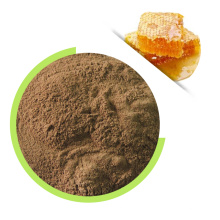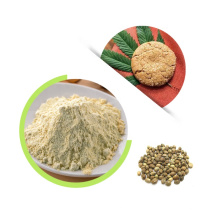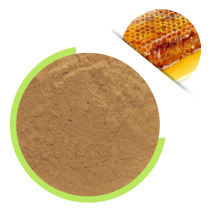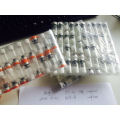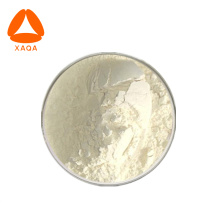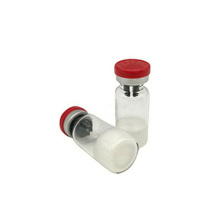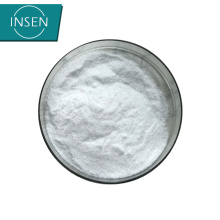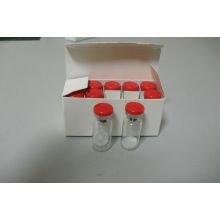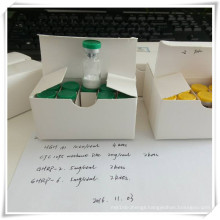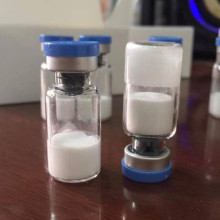High Quality Gdf-8 for Muscle Gaining with Best Price (10mg/vial)
Basic Info
Model No.: 77591-33-4
Product Description
Model NO.: 77591-33-4 Customized: Non-Customized Suitable for: Elderly, Adult Purity: ≦96% Type: Pharmaceutical Intermediate Grade: Medicine Grade Trademark: Filter Specification: 1mg/vial HS Code: 2801100000 Powder: Yes Certification: GMP, HSE, ISO 9001, USP, BP State: Solid Color: White Storage: Dry Cool Place Certificate: GMP Transport Package: Plastic Tube and Vial Origin: Shanghai Product Description Pharmaceutical Peptide 98% Purity Myostatin Peptide Gdf-8/Gdf8 with GMP Cerificated
Quick Details
Description
Myostatin (also known as growth differentiation factor 8, abbreviated GDF-8) is a myokine, a protein produced and released by myocytes that acts on muscle cells' autocrine function to inhibit myogenesis: muscle cell growth and differentiation. In humans it is encoded by the MSTN gene. Myostatin is a secreted growth differentiation factor that is a member of the TGF beta protein family.
Animals either lacking myostatin or treated with substances that block the activity of myostatin have significantly more muscle mass. Furthermore, individuals who have mutations in both copies of the myostatin gene have significantly more muscle mass and are stronger than normal. Blocking the activity of myostatin may have therapeutic application in treating muscle wasting diseases such as muscular dystrophy.
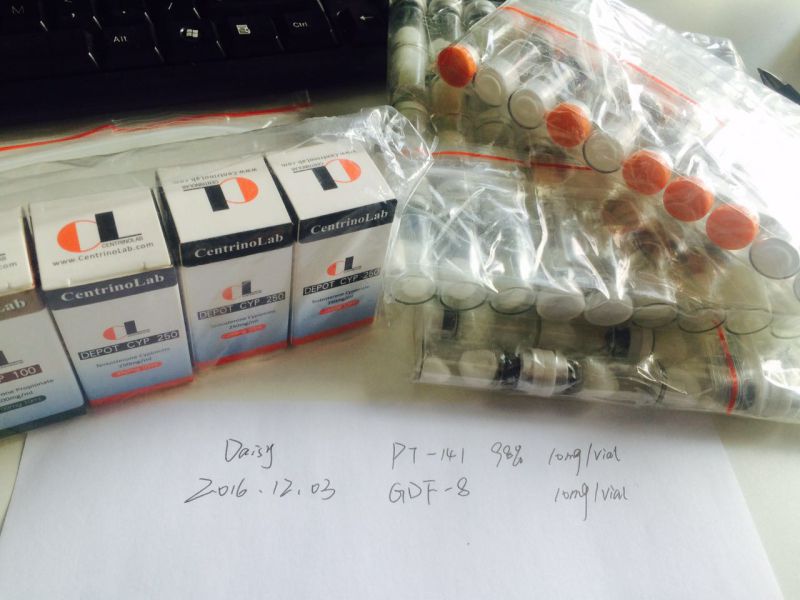
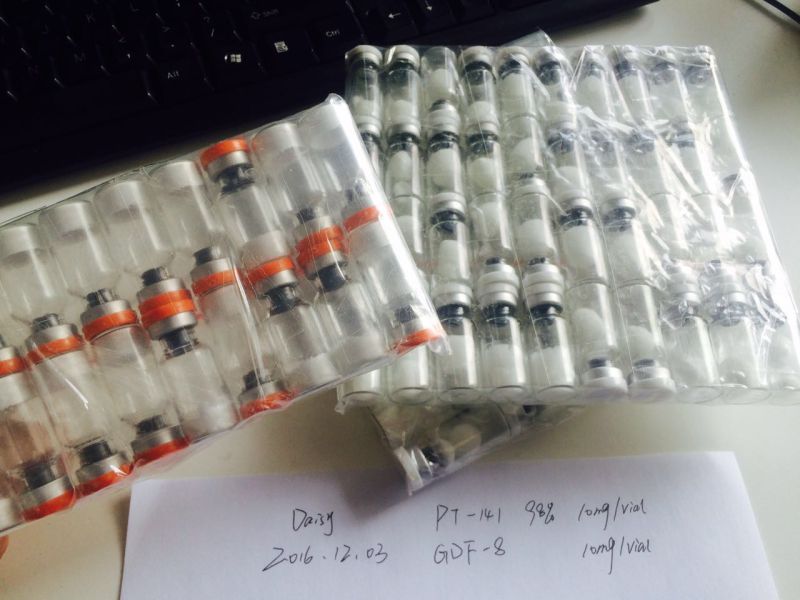

Usage
The gene encoding myostatin was discovered in 1997 by geneticists Se-Jin Lee and Alexandra McPherron who produced a strain of mutant mice that lack the gene. These myostatin "knockout" mice have approximately twice as much muscle as normal mice. These mice were subsequently named "mighty mice".
Naturally occurring deficiencies of myostatin have been identified in cattle by Ravi Kambadur, whippets, and humans; in each case the result is a dramatic increase in muscle mass. A mutation in the 3' UTR of the myostatin gene in Texel sheep creates target sites for the microRNAs miR-1 and miR-206. This is likely to cause the muscular phenotype of this breed of sheep.
Human myostatin consists of two identical subunits, each consisting of 109 (NCBI database claims human myostatin is 375 residues long) Amino Acid residues. Its total molecular weight is 25.0 kDa. The protein is inactive until a protease cleaves the NH2-terminal, or "pro-domain" portion of the molecule, resulting in the active COOH-terminal dimer. Myostatin binds to the activin type II receptor, resulting in a recruitment of either coreceptor Alk-3 or Alk-4. This coreceptor then initiates a cell signaling cascade in the muscle, which includes the activation of transcription factors in the SMAD family - SMAD2 and SMAD3. These factors then induce myostatin-specific gene regulation. When applied to myoblasts, myostatin inhibits their differentiation into mature muscle fibers.
Myostatin also inhibits Akt, a kinase that is sufficient to cause muscle hypertrophy, in part through the activation of protein synthesis. However, Akt is not responsible for all of the observed muscle hyperthrophic effects which are mediated by myostatin inhibition Thus myostatin acts in two ways: by inhibiting muscle differentiation, and by inhibiting Akt-induced protein synthesis.
A technique for detecting mutations in myostatin variants has been developed. Mutations that reduce the production of functional myostatin lead to an overgrowth of muscle tissue. Myostatin-related muscle hypertrophy has an incomplete autosomal dominance pattern of inheritance. People with a mutation in both copies of the MSTN gene in each cell (homozygotes) have significantly increased muscle mass and strength. People with a mutation in one copy of the MSTN gene in each cell (heterozygotes) have increased muscle bulk, but to a lesser degree.
In 2004, a German boy was diagnosed with a mutation in both copies of the myostatin-producing gene, making him considerably stronger than his peers. His mother has a mutation in one copy of the gene. An American boy born in 2005 was diagnosed with a clinically similar condition but with a somewhat different cause: his body produces a normal level of functional myostatin; but, because he is stronger and more muscular than most others his age, it is believed that a defect in his myostatin receptors prevents his muscle cells from responding normally to myostatin. He appeared on the television show, World's Strongest Toddler.
Further research into myostatin and the myostatin gene may lead to therapies for muscular dystrophy. The idea is to introduce substances that block myostatin. A monoclonal antibody specific to myostatin increases muscle mass in mice and monkeys.
A two-week treatment of normal mice with soluble activin type IIB receptor, a molecule that is normally attached to cells and binds to myostatin, leads to a significantly increased muscle mass (up to 60%). It is thought that binding of myostatin to the soluble activin receptor prevents it from interacting with the cell-bound receptors.
It remains unclear as to whether long-term treatment of muscular dystrophy with myostatin inhibitors is beneficial, as the depletion of muscle stem cells could worsen the disease later on. As of 2012, no myostatin-inhibiting drugs for humans are on the market. An antibody genetically engineered to neutralize myostatin, stamulumab, which was under development by pharmaceutical company Wyeth., is no longer under development. Some athletes, eager to get their hands on such drugs, turn to the internet where fake "myostatin blockers" are being sold.
Myostatin levels are effectively decreased by creatine supplementation.
Inhibition of myostatin leads to muscle hyperplasia and hypertrophy. Myostatin inhibitors can improve athletic performance and therefore there is a concern these inhibitors might be abused in the field of sports. However, studies in mice suggest that myostatin inhibition does not directly increase the strength of individual muscle fibers.
 Contact us if you need more details on Gdf8. We are ready to answer your questions on packaging, logistics, certification or any other aspects about Pharmaceutical Intermediate、Amino Acid. If these products fail to match your need, please contact us and we would like to provide relevant information.
Contact us if you need more details on Gdf8. We are ready to answer your questions on packaging, logistics, certification or any other aspects about Pharmaceutical Intermediate、Amino Acid. If these products fail to match your need, please contact us and we would like to provide relevant information.
Quick Details
| CAS No.: | 901758-09-6 | Other Names: | GDF-8 | MF: | C221H366N72O67S |
| EINECS No.: | N/A | Place of Origin: | Hubei, China (Mainland) | Type: | Immune Function Agents, Vitamins, Amino Acids and Coenzymes |
| Grade Standard: | Medicine Grade | Usage: | Animal Pharmaceuticals | ||
| Purity: | 85% | Product Name: | GDF-8 | ||
| Chemical Name: | Growth Differentiation Factor 8 | Appearance: | White powder | Dry: | Freeze |
| Assay: | HPLC 99% | Package`: | 1 mg/vial | Other Name: | Myostatin |
Description
Myostatin (also known as growth differentiation factor 8, abbreviated GDF-8) is a myokine, a protein produced and released by myocytes that acts on muscle cells' autocrine function to inhibit myogenesis: muscle cell growth and differentiation. In humans it is encoded by the MSTN gene. Myostatin is a secreted growth differentiation factor that is a member of the TGF beta protein family.
Animals either lacking myostatin or treated with substances that block the activity of myostatin have significantly more muscle mass. Furthermore, individuals who have mutations in both copies of the myostatin gene have significantly more muscle mass and are stronger than normal. Blocking the activity of myostatin may have therapeutic application in treating muscle wasting diseases such as muscular dystrophy.



Usage
The gene encoding myostatin was discovered in 1997 by geneticists Se-Jin Lee and Alexandra McPherron who produced a strain of mutant mice that lack the gene. These myostatin "knockout" mice have approximately twice as much muscle as normal mice. These mice were subsequently named "mighty mice".
Naturally occurring deficiencies of myostatin have been identified in cattle by Ravi Kambadur, whippets, and humans; in each case the result is a dramatic increase in muscle mass. A mutation in the 3' UTR of the myostatin gene in Texel sheep creates target sites for the microRNAs miR-1 and miR-206. This is likely to cause the muscular phenotype of this breed of sheep.
Human myostatin consists of two identical subunits, each consisting of 109 (NCBI database claims human myostatin is 375 residues long) Amino Acid residues. Its total molecular weight is 25.0 kDa. The protein is inactive until a protease cleaves the NH2-terminal, or "pro-domain" portion of the molecule, resulting in the active COOH-terminal dimer. Myostatin binds to the activin type II receptor, resulting in a recruitment of either coreceptor Alk-3 or Alk-4. This coreceptor then initiates a cell signaling cascade in the muscle, which includes the activation of transcription factors in the SMAD family - SMAD2 and SMAD3. These factors then induce myostatin-specific gene regulation. When applied to myoblasts, myostatin inhibits their differentiation into mature muscle fibers.
Myostatin also inhibits Akt, a kinase that is sufficient to cause muscle hypertrophy, in part through the activation of protein synthesis. However, Akt is not responsible for all of the observed muscle hyperthrophic effects which are mediated by myostatin inhibition Thus myostatin acts in two ways: by inhibiting muscle differentiation, and by inhibiting Akt-induced protein synthesis.
A technique for detecting mutations in myostatin variants has been developed. Mutations that reduce the production of functional myostatin lead to an overgrowth of muscle tissue. Myostatin-related muscle hypertrophy has an incomplete autosomal dominance pattern of inheritance. People with a mutation in both copies of the MSTN gene in each cell (homozygotes) have significantly increased muscle mass and strength. People with a mutation in one copy of the MSTN gene in each cell (heterozygotes) have increased muscle bulk, but to a lesser degree.
In 2004, a German boy was diagnosed with a mutation in both copies of the myostatin-producing gene, making him considerably stronger than his peers. His mother has a mutation in one copy of the gene. An American boy born in 2005 was diagnosed with a clinically similar condition but with a somewhat different cause: his body produces a normal level of functional myostatin; but, because he is stronger and more muscular than most others his age, it is believed that a defect in his myostatin receptors prevents his muscle cells from responding normally to myostatin. He appeared on the television show, World's Strongest Toddler.
Further research into myostatin and the myostatin gene may lead to therapies for muscular dystrophy. The idea is to introduce substances that block myostatin. A monoclonal antibody specific to myostatin increases muscle mass in mice and monkeys.
A two-week treatment of normal mice with soluble activin type IIB receptor, a molecule that is normally attached to cells and binds to myostatin, leads to a significantly increased muscle mass (up to 60%). It is thought that binding of myostatin to the soluble activin receptor prevents it from interacting with the cell-bound receptors.
It remains unclear as to whether long-term treatment of muscular dystrophy with myostatin inhibitors is beneficial, as the depletion of muscle stem cells could worsen the disease later on. As of 2012, no myostatin-inhibiting drugs for humans are on the market. An antibody genetically engineered to neutralize myostatin, stamulumab, which was under development by pharmaceutical company Wyeth., is no longer under development. Some athletes, eager to get their hands on such drugs, turn to the internet where fake "myostatin blockers" are being sold.
Myostatin levels are effectively decreased by creatine supplementation.
Inhibition of myostatin leads to muscle hyperplasia and hypertrophy. Myostatin inhibitors can improve athletic performance and therefore there is a concern these inhibitors might be abused in the field of sports. However, studies in mice suggest that myostatin inhibition does not directly increase the strength of individual muscle fibers.
 Contact us if you need more details on Gdf8. We are ready to answer your questions on packaging, logistics, certification or any other aspects about Pharmaceutical Intermediate、Amino Acid. If these products fail to match your need, please contact us and we would like to provide relevant information.
Contact us if you need more details on Gdf8. We are ready to answer your questions on packaging, logistics, certification or any other aspects about Pharmaceutical Intermediate、Amino Acid. If these products fail to match your need, please contact us and we would like to provide relevant information. Product Categories : Peptide for Muscle Building
Premium Related Products
Other Products
Hot Products
Pharmaceutical Peptides Over 98% CAS 77591-33-4 2mg/Vial Thymosin Beta 4 /Tb500Lab Supply GMP Certified Bcp-157 CAS: 137525-51-0 at Hot SaleRaw Powder Deslorelin Acetate for Adult with GMP ApprovedGood Resouce Lanreotide with Raw Powder2016 Hot Sale Factory Price Fast Delivery Pharmaceutical Peptide Melanotan 2 CAS 121062-08-6Selank Lab Supply High Purity 98% Peptides Selank for Research with GMPHigh Quality PT-141 32780-32-8 Peptide for Sexual DysfunctionHigh Purity Carperitide 89213-87-6 with Best PriceGonadorelin Acetate 99%Purity Peptide, Gonadorelin PriceHigh Purity Gh 176-191 for Muscle Growth with GMP (10iu/vial)(Dispel freckle and whiten skin) Peptide Tetrapeptide-30 with GMP CAS 56-81-5Peptide Supply Peptide Product Ghrp6, Top Grade Ghrp6 - Buy Peptide Hormone, CAS 87616-84-0Hot Sale Cjc-1295 for Bodybuilding with GMP SGS (with DAS)Pharmaceutical Intermediate Peptides for Loss Weight 1mg/Vial Igf-1lr3 / MgfResearch Chemical Peptide Ghrp-2 Supplier From ChinaPharmaceutical Peptide Build Muscle/Loss Weight 5mg/Vial Ghrp-2 with Lab Supply
